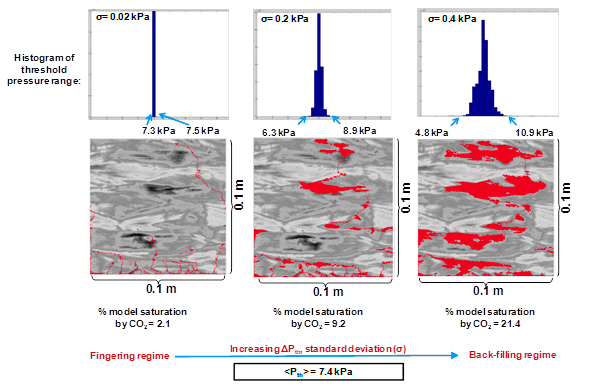Texas Offshore Miocene Project, Task 5.1
Modeling
When CO2 is injected into a storage reservoir during sequestration, viscous forces dominate flow near the wellbore due to high injection rates and large pressure gradients. As CO2 moves away from the injectors, the pressure from injection becomes negligible compared to buoyancy forces. Flow depends on two factors: the capillary pressure of the leading edge of the plume (Pc) and the range of threshold entry pressures within the rock at the leading edge of the plume (Pth). The seal rock is a different rock type with very high threshold pressure values Pthseal compared to the reservoir rock.
The figure below shows how the CO2 plume moves through distance and time. Outlines of plume are presented at times t1, t2, t3, t4, and t5. The vertical dimension is extremely exaggerated. Possible flow regimes are: (a) compact flow where capillary pressure dominates, (b) capillary channel flow where capillary flow is within the range of threshold entry pressures, and (c) secondary accumulation beneath a seal where capillary pressure is less than the smallest threshold entry pressure.

The model domain is a digital representation of a physical geologic specimen. The specimen is a sedimentary relief peel sample (1.0 m × 0.5 m) of alluvium extracted from the upper portions of a modern point bar of the Brazos River, Texas. The following procedures were used:
- Subjected peel specimen to high-resolution laser scanning and imaging techniques to study epoxy imbibition and grain size distribution;
- Prepared digital elevation map from topographical variations in the peel;
- Generated digital high-resolution model representing the threshold pressure distribution of the model domain corresponding to the determined topography. Higher elevations correspond with greater imbibitions as a result of smaller average grain size and they are represented in the figure below with hotter colors.

Simulations were performed using a modified invasion percolation software, Permedia® (distributed by Halliburton). High-resolution simulations indicate that capillary channels efficiently transport all CO2 that enters the domain through a few narrow, generally vertical pathways. The CO2 flow pattern is characterized as 'fingering'. Only 2.86% of the model domain is saturated with CO2.

We then used the model to evaluate the relevant features of heterogeneity:
(1) grain size distribution, which determines the mean and range of threshold pressures, and
(2) correlation lengths of threshold pressures in horizontal and vertical directions.
CASE 1: Effect of threshold pressure range on CO2 migration regime
As grain size distribution widens, CO2 migration in capillary channels transitions from a fingering to a back-filling pattern, as shown below. Storage efficiency decreases as buoyancy and heterogeneity enable much CO2 to migrate longer distances with lower rock contact volume. A higher percentage of the domain becomes saturated with CO2.

CASE 2: Effect of correlation length of threshold pressures on CO2 migration regime
The ratio of horizontal and vertical correlation lengths of threshold pressures influences the size of CO2 accumulations, as shown below. Higher ratios of horizontal to vertical correlation lengths lead to more lateral movement of CO2 with increasing accumulations. Consequently, the tendency of CO2 to back-fill and thus contact more rock is greater as it migrates. This reiterates the importance of the underlying geologic fabric in influencing CO2 migration regime.

Summary
- Modeling the dominant flow physics at the appropriate scale is important for valid estimates of CO2 migration and effective saturation.
- CO2flow patterns vary from finger-like structures with minimal rock contact to back-filling structures. For the depositional fabric considered, 3% of the domain gets filled by CO2 when it fingers, while back-filling migration pattern leads to 30% saturation.
- More spatial correlation and wider grain size distributions are conducive to the back-filling migration pattern. These make preferred storage sites compared to domains driving fingering migration patterns.
- Models that neglect the capillary channel flow regime would predict low storage efficiency, and consequently CO2 migrating greater distances than expected.
Task 5.2: Caprock Seal Capacity
<< Back to Texas Offshore Miocene Project main page || << view previous Task || view next Task >>



